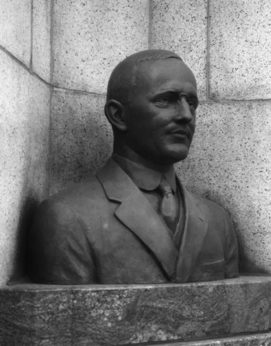
The Holland Tunnel, running under the Hudson River between New York, N.Y., and Jersey City, N.J., opened to traffic 90 years ago on November 13, 1927.
The tunnel was built and operated by the New York-New Jersey Bridge and Tunnel Commission. Comprising two tubes, each large enough for two lanes of traffic, the Holland was the first underwater vehicular tunnel built in the United States. It is an integral conduit within the New York metropolitan area, and is operated by the Port Authority of New York and New Jersey. The tunnel carries west-east Interstate 78, while the New Jersey section concurrently carries Route 139. A second tunnel for vehicles, the Lincoln Tunnel, opened in 1937.

Originally known as the Hudson River Vehicular Tunnel or the Canal Street Tunnel, it was renamed the Holland Tunnel in memory of Clifford Milburn Holland, the chief engineer, after his untimely death in 1924. The innovative ventilation system was designed by Ole Singstad, who oversaw completion of the tunnel’s construction.
Begun in 1920, the tunnel was the first mechanically ventilated underwater vehicular tunnel in the world. Eighty-four fans, in four ventilation buildings, create a floor-to-ceiling air flow across the roadway at regular intervals, via systems of ducts beneath and above the roadway. The fans can completely change the air inside the tunnel every 90 seconds. A forced ventilation system is essential because of the poisonous carbon monoxide component of automobile exhaust.
The pair of tubes are each over 8000 feet from end to end, and are situated in the bedrock beneath the river. The lowest point of the roadway is 93 feet below mean high water. It is used by over 35 million vehicles per year. It was designated a National Historic Civil and Mechanical Engineering Landmark in 1982 and a National Historic Landmark in 1993.
For centuries, passage across the lower Hudson River was possible only by ferry. The first tunnels below the Hudson River were constructed in the first decade of the 20th century to link the major railroad terminals in New Jersey with Manhattan Island. Once tunneling had been shown to be feasible, increasing automobile traffic led to interest in a roadway crossing the river as well. A bridge was considered, but the cost of land for accessways to a suitably raised bridge would be prohibitive as a height of 200 feet was deemed the minimum necessary to avoid interfering with shipping.
In 1920, the Tunnel Commission appropriated funds for the design proposed by engineer Clifford Milburn Holland. Construction began on March 31, 1922, with a crew of workers starting to dig at the corner of Canal and West Streets. On October 27, 1924, the day before the two halves of the tunnel were scheduled to be linked, 41-year-old Holland died of a heart attack attributed to the stress from overseeing the tunnel’s construction. “Holing through” ceremonies scheduled for that day, in which President Calvin Coolidge would have remotely set off an explosion to connect the two sides of the tunnel, were canceled out of respect for Holland’s death.
Holland was succeeded by Milton Harvey Freeman, who died of pneumonia in March 1925, after several months heading the job. After Freeman’s death, Ole Singstad oversaw the completion of the tunnel.
Tunnel construction required workers to spend large amounts of time in the caisson under high pressure of up to 47.5 pounds per square inch, which was thought to be necessary to prevent river water from entering prior to completion of the tubes. “Sandhogs,” as they were termed, entered the tunnel through a series of airlocks, and could only remain inside of the tunnel for a designated time period. On exiting the tunnel, the workers had to undergo controlled decompression to avoid the bends, a condition in which nitrogen bubbles form in the blood from rapid decompression.
Fortunately, no workers died as a result of decompression sickness. The project involved 756,000 decompressions over the course of the construction. There were 528 cases of the bends, none fatal. Completion of the tunnel took nearly seven years and claimed the lives of 14 workers. The blacklisted artists writer Waldo Salt and composer Earl Robinson collaborated on the 1954 musical, or folk opera, called Sandhog, based on a Theodore Dreiser story about the mostly Irish-American community of workers who built the New York City tunnels.
Sources: Chase’s Calendar of Events, Wikipedia.









